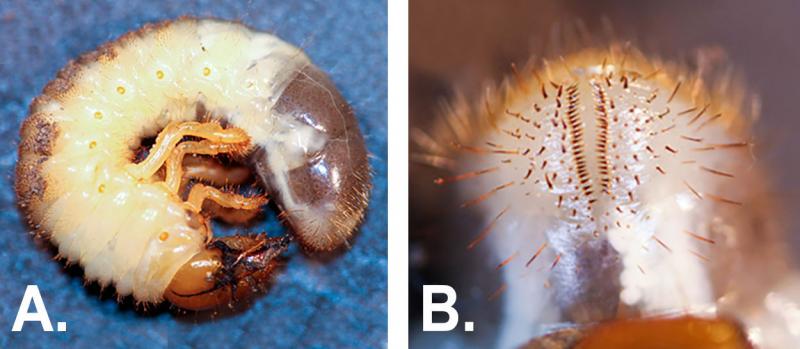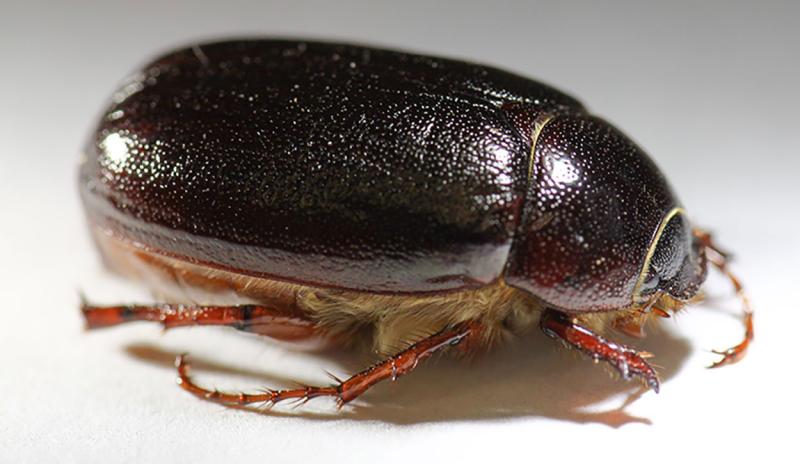Originally Submitted: May 10, 2021
We’ve had quite a few calls about dead patches of grass in lawns this spring, which could be a sign of grub activity. It is important to remember that a dead patch of grass does not always indicate grub activity, so it is important to investigate further before deciding on a management plan. The best way to determine if grubs are the culprit is to dig two-to-six inches into the soil at the edge of the damaged areas and examine the soil for grubs or the adult beetles. In South Dakota, there are numerous species of grubs that can cause issues in lawns. The treatment for these grubs is the same, but there is some variation in their life cycles. For example, true white grubs, which are very common in South Dakota, have a three-year life cycle (multi-year). Northern masked chafers and Japanese beetles, which can also be found in South Dakota, have a one-year life cycle (annual populations). Japanese beetle populations are currently most prevalent in the southeast corner of the state and extend up the I-29 corridor.
Grub Injury to Lawns
Grubs feed on the root tissue of the grass, which causes the plant to wilt and eventually die. In areas with grubs, the grass will turn light brown with initial feeding. Severe injury to root tissue will cause the grass to turn brown. In areas with severe feeding, the grass may be easily peeled back from the soil, like lifting a carpet. These areas may also be subject to secondary digging damage from animals that are hunting for the grubs.
True White Grub Description

The true white grub larvae are almost always C-shaped when observed in the soil (Figure 1-A). The larvae have a brown head capsule, and three pairs of light-brown to cream-colored legs.
As their name implies, most of the body is a white-to-cream colored. The ends of their bodies are often slightly darker with small hairs at the tip. True white grubs have a distinct pattern of hairs, which is referred to as a “zipper” (Figure 1-B).
Adult True White Grub Description

The adult true white grubs are referred to as May or June beetles. These beetles are typically fairly large and vary in color from light to dark brown (Figure 2). These beetles have light-brown legs and a tan layer of hairs on their undersides. The adults are most-frequently observed at night and are attracted to lights.
Grub Detection and Monitoring
If you observe areas in your lawn that are not greening up or appear to be dying, it is important to scout to determine if grubs are present. To do this, use a shovel to dig approximately three-inches deep around a one-square-foot section of the lawn. Pull the section of the grass back and examine the soil for the presence of grubs or adult beetles. We recommend scouting around the border of the injury, as the grubs aren’t typically present in the areas that are already severely damaged. The threshold for grubs in lawns is five-to-10 grubs per a square-foot area.
Current Management Recommendations
Proper lawn care can play a vital role in grub management. Vigorous lawns can tolerate some grub feeding with proper care. If very large populations are being observed and there are large patches of dead grass, insecticides may be required. If grub populations are detected early, they can be managed effectively before the lawn is damaged. However, the grubs can also be managed after damage has been observed. For effective management, we recommend hiring a lawn care professional to apply insecticides that are labeled for grubs.
There are two strategies for using insecticides to manage grubs: applying them as a preventative or as a curative. Preventative applications are done in July/Aug. to reduce damage from the grubs that will hatch later in the summer. These treatments will not do anything for the grubs found in the spring. Curative applications are the ones intended to kill grubs in the spring, and while it may feel satisfying to kill them, this is not the most-effective strategy. The grubs this spring are reaching their largest size and may have even begun to pupate (a life stage that the insecticides do not affect). For this reason, scouting and determining the size and stage of the grubs is important.


